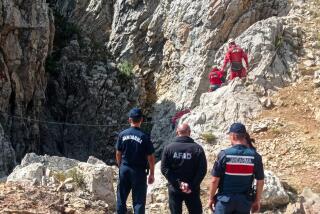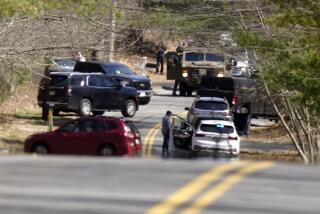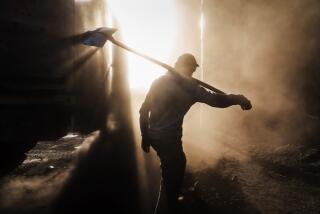U.S. Search for Information on Terrorists Goes Underground
- Share via
U.S. forces are searching cave complexes and bunkers in eastern Afghanistan to find information that U.S. officials say could be used to thwart further terrorist attacks by the Al Qaeda network, the commander of American forces in the region said Friday.
U.S. personnel already are in possession of computers, hard drives and diaries, as well as “several filing cabinets full of documentary evidence that we have taken out and are in the process of going through very methodically right now,” Gen. Tommy Franks, the head of the U.S. Central Command, told reporters.
Franks said the search is focused around the towns of Khost and Gardez, an area in the vicinity of a massive cave complex at Zhawar Kili that was subjected to nearly two weeks of airstrikes this month. Defense Department officials have said the region includes pockets of Al Qaeda and Taliban resistance.
“We have forces there now, working with Afghan units, out finding and working our way through some of these cave complexes and bunker sites,” Franks said, adding: “We’re in a hurry to get to them, because . . . we want to preempt the possibility of a future attack or gain insights into that.”
There are signs that the information being acquired in Afghanistan is reaping some benefits for the U.S.-led war on terrorism.
The Justice Department on Thursday released excerpts of videotapes recently discovered in the bombed house of slain Al Qaeda commander Muhammad Atef showing five men who it said may be planning suicide attacks against Western targets. U.S. officials credit seized information with foiling attacks planned in Singapore.
Although officials have not connected them with the intelligence-collection effort, there has been a new round of arrests of suspected terrorists in recent days in the Philippines, Bosnia and Britain.
Franks, without offering specific examples, said the information being uncovered in Afghanistan is being used to build a “mosaic” to combat terrorism around the globe. “It would be accurate to say insights have been gained, such as the insights into the potential problem in Singapore,” Franks said.
Franks offered no information, however, about whether the U.S. government had learned anything new about the whereabouts of Al Qaeda leader Osama bin Laden, who is charged with last year’s attacks on the United States, or Mohammad Omar, head of Afghanistan’s deposed Taliban regime that sheltered bin Laden’s fighters.
Franks and other U.S. officials discounted comments made Friday by Pakistan President Gen. Perez Musharraf, in which he said Bin Laden is probably dead because he was unable to get treatment for a kidney ailment.
“I would give the first priority that he is dead and the second priority that he is alive somewhere in Afghanistan,” Musharraf said in an interview with CNN.
Asked to comment, Franks said, “I’ve received no intelligence to that effect. . . . I’ve not seen anything in intelligence that would confirm or deny that.”
A senior U.S. official said the CIA also had no information to support Musharraf’s statement.
Musharraf told CNN that Pakistan had information that Bin Laden took two dialysis machines into Afghanistan. “One was specifically for his own personal use,” Musharraf said. He said Bin Laden may not have been able to receive treatment since the U.S. military campaign began last fall.
A U.S. official said, “We don’t have any evidence that he has been on kidney dialysis.” The official added, “There have been rumors that he has health problems, maybe kidney stones.”
Defense Secretary Donald Rumsfeld said Wednesday that Bin Laden is likely still in Afghanistan, but Franks seemed less confident of this Friday. “We really don’t know where he is, whether he’s in Afghanistan or whether he may have left,” he said.
But Franks vowed Bin Laden would be found. “The world is not a large enough place for him to hide,” he said.
In his comments Friday, Franks characterized the work by U.S. forces in eastern Afghanistan more as an intelligence-gathering effort than a manhunt.
In addition to information, Franks said, the forces have found significant amounts of ammunition and equipment. “We have found an awful lot,” Franks said. “We have learned an awful lot. We have not yet found any weapons of mass destruction. We have found potential. We have certainly found a desire on the part of Al Qaeda to have weapons of mass destruction.”
Franks said U.S. forces are receiving assistance from Afghan tribal leaders. “We have found with the tribal shuras in the area is that they remain ready to cooperate with us,” he said.
Representatives of the International Committee of the Red Cross arrived Friday at the U.S. Naval base at Guantanamo Bay, Cuba, where the military is holding 110 Al Qaeda and Taliban detainees. The Red Cross officials have not yet spoken to the prisoners, Franks said. Some human rights groups have raised concerns about the treatment of the detainees.
For U.S. commanders, the prisoners may hold more secrets that could lead to further intelligence gains, Franks said. “The first thing we know is that we want to interrogate these detainees for intelligence value,” he said.
More to Read
Sign up for Essential California
The most important California stories and recommendations in your inbox every morning.
You may occasionally receive promotional content from the Los Angeles Times.













